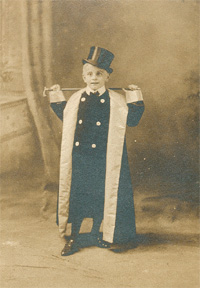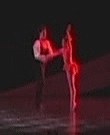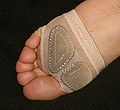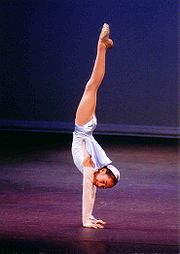
Acro dance
Encyclopedia

Dance
Dance is an art form that generally refers to movement of the body, usually rhythmic and to music, used as a form of expression, social interaction or presented in a spiritual or performance setting....
that combines classical dance technique with precision acrobatic elements. It is defined by its athletic character, its unique choreography
Choreography
Choreography is the art of designing sequences of movements in which motion, form, or both are specified. Choreography may also refer to the design itself, which is sometimes expressed by means of dance notation. The word choreography literally means "dance-writing" from the Greek words "χορεία" ...
, which seamlessly blends dance and acrobatics, and its use of acrobatics in a dance context. It is a popular dance style in amateur competitive dance
Competitive dance
Competitive dance is a popular, widespread activity in which competitors perform dances in any of several permitted dance styles—such as acro, ballet, jazz, hip-hop, lyrical, modern, and tap—before a common group of judges...
as well as in professional dance theater and contemporary circus
Contemporary circus
Contemporary circus, or nouveau cirque , is a genre of performing art developed in the later 20th century in which a story or a theme is conveyed through traditional circus skills. Animals are rarely used in this type of circus, and traditional circus skills are blended with a more character-driven...
productions such as those by Cirque du Soleil
Cirque du Soleil
Cirque du Soleil , is a Canadian entertainment company, self-described as a "dramatic mix of circus arts and street entertainment." Based in Montreal, Quebec, Canada, and located in the inner-city area of Saint-Michel, it was founded in Baie-Saint-Paul in 1984 by two former street performers, Guy...
. This is in contrast to rhythmic
Rhythmic gymnastics
Rhythmic gymnastics is a sport in which individuals or teams of competitors manipulate one or two pieces of apparatus: rope, clubs, hoop, ball, ribbon and Free . An individual athlete only manipulates 1 apparatus at a time...
and artistic gymnastics
Artistic gymnastics
Artistic gymnastics is a discipline of gymnastics where gymnasts perform short routines on different apparatus, with less time for vaulting . The sport is governed by the Federation Internationale de Gymnastique , which designs the Code of Points and regulates all aspects of international elite...
, which are sports that employ dance elements in a gymnastics context, with each being regulated by a governing gymnastics organization and Code of Points. Acro dance is known by various other names including acrobatic dance and gymnastic dance, though it is most commonly referred to simply as acro by dancers and dance professionals.
Acro is an especially challenging dance style for dancers as it requires them to be trained in both dance and acrobatic skills. Acro dancers must be in excellent physical condition as well, because acro is a physically demanding activity. Although acro is a popular dance style, many dance schools do not teach it, often due to lack of facilities or expertise needed for acrobatic training.
History

United States
The United States of America is a federal constitutional republic comprising fifty states and a federal district...
and Canada
Canada
Canada is a North American country consisting of ten provinces and three territories. Located in the northern part of the continent, it extends from the Atlantic Ocean in the east to the Pacific Ocean in the west, and northward into the Arctic Ocean...
in the early 1900s as one of the types of acts performed in vaudeville
Vaudeville
Vaudeville was a theatrical genre of variety entertainment in the United States and Canada from the early 1880s until the early 1930s. Each performance was made up of a series of separate, unrelated acts grouped together on a common bill...
. Although individual dance and acrobatic acts had been performed in vaudeville for several decades prior to 1900, it was not until the early 1900s that it became popular to perform acts that combined dance and acrobatic movements.
Acrobatic dance did not suddenly appear in vaudeville; rather, it appeared gradually over time in a variety of forms, and consequently no individual performer has been cited as its originator. Sherman Coates, who performed with the Watermelon Trust from 1900 to 1914, was recalled by fellow dancers as the first acrobatic dancer they had ever seen. Another of the earliest documented acrobatic dance performers was Tommy Woods, who became well known for his slow-motion acrobatic dance in Shuffle Along, in which he would execute acrobatic movements precisely in time with the music. In 1914, acrobat Lulu Coates formed the Crackerjacks, a popular vaudeville troupe that included acrobatic dance in their performance repertoire up until the group disbanded in 1952. Many other popular vaudeville companies combined acrobatics and dance in their shows, including the Gaines Brothers.
Since the decline of the vaudeville era, acrobatic dance has undergone a multi-faceted evolution to arrive at its present-day form. The most significant aspect of this evolution is the integration of ballet technique as the foundation for dance movements, thus bringing into acro dance a precision of form and movement that was absent in vaudeville acrobatic dance. Also, vaudeville acrobatic dances were often little more than acrobatics set to music, whereas modern acro dance is fundamentally dance, with its acrobatic movements performed in a dance context.
Characteristics
A defining characteristic of acro is the smooth, graceful transitions between dance and acrobatic movements. Also, a dance must have a significant percentage of dance movement, with respect to its acrobatic content, in order for it to be categorized as acro. For example, a gymnastics floor exerciseFloor (gymnastics)
In gymnastics, the floor refers to a specially prepared exercise surface, which is considered an apparatus. It is used by both male and female gymnasts. The event in gymnastics performed on floor is called floor exercise. The English abbreviation for the event in gymnastics scoring is FX.A spring...
is not considered to be acro because it has little or no dance movement compared to its acrobatic content, and also because it lacks smooth transitions between dance and gymnastic movements.
Dance technique
The dance movements in acro are founded in balletBallet
Ballet is a type of performance dance, that originated in the Italian Renaissance courts of the 15th century, and which was further developed in France and Russia as a concert dance form. The early portions preceded the invention of the proscenium stage and were presented in large chambers with...
, jazz
Jazz dance
Jazz dance is a classification shared by a broad range of dance styles. Before the 1950s, jazz dance referred to dance styles that originated from African American vernacular dance. In the 1950s, a new genre of jazz dance—modern jazz dance—emerged, with roots in Caribbean traditional dance...
, lyrical
Lyrical dance
Lyrical dance is a fusion of ballet with jazz and contemporary dance techniques.You can also get lyrical gymnastics which is gymnastics to music. It has a dance influence to it....
and modern dance
Modern dance
Modern dance is a dance form developed in the early 20th century. Although the term Modern dance has also been applied to a category of 20th Century ballroom dances, Modern dance as a term usually refers to 20th century concert dance.-Intro:...
styles. Acro dance movements are not restricted to these dance styles, but the complete absence of these styles will typically cause a dance to be categorized as something other than acro (e.g., breakdance).
Acrobatic elements
The acrobatic movements performed in an acro dance are referred to as tricks. Numerous tricks are commonly performed in acro dances, varying widely in complexity and the skills required to perform them. Aside from the obvious requirement that dancers possess the requisite skills to perform tricks, the types of tricks that can be performed in an acro dance depends on the number of dancers.Solo tricks can be performed by independent dancers in solo
Solo (dance)
A solo dance is danced by an individual dancing alone, as opposed to couples dancing together but independently of others dancing at the same time, if any, and as opposed to groups of people dancing simultaneously in a coordinated manner. Solo dancers are usually the best dancers in a group or...
or group dances. Examples of this are:
|
 |
 |
 |
Double tricks—also known as partnering tricks—can only be performed by a pair of dancers. An example of this is the pitch tuck, in which one dancer forms a "saddle" with his hands. The second dancer steps onto the saddle and then the first dancer thrusts the saddle upward. The second dancer, who is propelled upward with back rotation, lands on her feet after a complete revolution in the air. Acro partners will sometimes execute lifts and adagio in addition to single and double tricks.
|
 |
 |
 |
Group tricks generally require three or more dancers. Examples of this are:
- Bridge pyramid
- Triple cartwheel
Footwear


Barefoot
Barefoot is the state of not wearing any footwear. Being barefoot is regarded as a human's natural state, though for functional, fashion and social reasons footwear is worn, at least on some occasions...
and rely on the standard gymnastics floor for traction and cushioning, acro dancers seldom dance barefoot, instead depending on footwear such as acro shoes or foot thongs to provide the necessary traction and cushioning.
All of the most common types of acro footwear provide both traction and cushioning. In addition, acro performance surfaces are frequently rough, so acro footwear must protect the bottom of the foot from skin abrasion. Abrasion protection is particularly important on the ball of the foot, which is subjected to a great deal of friction
Friction
Friction is the force resisting the relative motion of solid surfaces, fluid layers, and/or material elements sliding against each other. There are several types of friction:...
during dance leaps and turns. Traction
Traction (engineering)
Traction refers to the maximum frictional force that can be produced between surfaces without slipping.The units of traction are those of force, or if expressed as a coefficient of traction a ratio.-Traction:...
is essential to prevent lateral slipping that could result in dangerous falls to the hard floor. Cushioning
Cushioning
Package cushioning is used to help protect fragile items during shipment. It is common for a transport package to be dropped, kicked, and impacted: These events may produce potentially damaging shocks. Transportation vibration from conveyors, trucks, railroads, or aircraft can also damage some...
serves to soften the impact when performing tricks such as tucks and layouts, in which a dancer's feet may strike the floor at high velocity
Velocity
In physics, velocity is speed in a given direction. Speed describes only how fast an object is moving, whereas velocity gives both the speed and direction of the object's motion. To have a constant velocity, an object must have a constant speed and motion in a constant direction. Constant ...
. Cushioning is especially important when a Marley floor is unavailable, because uncovered performance surfaces have no cushioning whatsoever and thus may be extremely hard and unyielding.
Acro shoes
Acro dancers most often wear jazz dance shoes, which are commonly referred to as acro shoes by acro dancers. Acro shoes are called jazz boots, jazz ankle boots, jazz booties and other names, by their various manufacturers. They are typically laceless, slip-on shoes, with tight-fitting leather uppers that are designed to prevent the dancer's feet from shifting inside the shoes. Because of their thin, pliable leather uppers and split soles, acro shoes have excellent flexibility, thus enabling dancers to attain both good dance form and acrobatic control. The sole is made of soft, composite rubber so as to provide both high traction and cushioning, and it provides excellent protection from skin abrasion as it covers the entire bottom of the foot.Foot thongs
Less commonly, acro dancers may wear foot thongs, which are variously called Dance Paws and FootUndeez, depending on the manufacturer. Foot thongs—which are slip-on, partial foot covers that protect only the ball of the foot—are sometimes preferred over acro shoes for aesthetic reasons. In particular, flesh colored foot thongs endow the wearer with the appearance of having bare feet, while retaining some degree of the traction, cushioning, and abrasion protection provided by acro shoes.Clothing

Safety
Safety is the state of being "safe" , the condition of being protected against physical, social, spiritual, financial, political, emotional, occupational, psychological, educational or other types or consequences of failure, damage, error, accidents, harm or any other event which could be...
and aesthetic reasons. Form-fitting clothing is preferred over loose clothing because the latter does not move synchronously
Synchronization
Synchronization is timekeeping which requires the coordination of events to operate a system in unison. The familiar conductor of an orchestra serves to keep the orchestra in time....
with the body and thus may interfere with a dancer's ability to maintain control. This is especially important when a dancer is performing tricks, as loss of control can lead to serious injury. Aside from the safety aspect, form-fitting clothing also helps to expose a dancer's body lines, which can add significantly to the visual impact of an acro dance performance.
Competitive acro dancers frequently wear costumes
Dance costumes
The purpose of a dance costume is to enhance the dancer’s body and the concept of the choreographer . “Costumes are clothes and they are art. They make the invisible ideas visible”...
when performing at dance competitions. Acro costumes often have loose fabric
Fabric
A fabric is a textile material, short for "textile fabric".Fabric may also refer to:*Fabric , the spatial and geometric configuration of elements within a rock*Fabric , a nightclub in London, England...
pieces such as short skirts, but the sizes and locations of these pieces are carefully calculated to ensure that they pose no safety risks. As an extra safety measure, skirts are sometimes pinned or stitched at the back below the waistline so that they will not hang at full length when the dancer is inverted, as in hand walking
Hand walking
Hand walking is an unusual form of human locomotion in which a person travels in a vertically inverted orientation with all body weight resting on the hands.It can be executed with legs fully extended or with variations such as stag, straddle or front splits...
; this prevents the skirt—which might otherwise become entangled in the dancer's hair or costume headpiece
Headpiece
Headpiece can refer to:*A typically thin metallic crown, headband, or tiara worn around the forehead. Commonly worn by ancient rulers, such as Cleopatra, headpieces usually carry some emblem of religious or political significance....
—from contacting the dancer's head.

